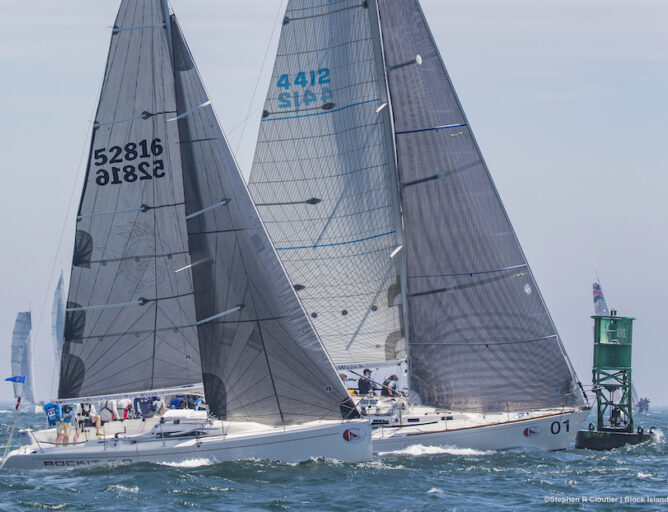While the forecast changes every time and the current of the day might vary, there are a few go-to moves in getting around the island
By Anderson Reggio, Fleet Captain Storm Trysail Club, Photo: Steve Cloutier
The highlight for many of us during Block Island Race Week is the Around the Island Race, an 18-mile jaunt on the day the organizers deem best. This is not a simple adventure, but rather a tactically challenging race around a topographically diverse landmass. Typically raced in a building southwesterly breeze in a counter-clockwise direction, there are a few key points around the track. Current, wind bends and funneling all play a factor in executing a solid plan to claim the trophy.
Around the island, the current is fairly predictable. On the flood, it flows from the south, taking a northerly direction on the east side of the island and a northwesterly direction on the southwest side. Current flow around the southwest corner can easily reach 2 knots, so this is a crucial area to play. On the west side of the island, and in particular the starting area, the flow can vary in speed and direction dramatically because the water bends around the island from both the north and the west on the flood and retreats in both directions on the ebb, fanning out from the Great Salt Pond. Real-time current observations early up the track are important to getting the first beat right.
Off the starting line, the race committee typically likes to see the first beat be reasonably square to the breeze. In our assumed southwesterly flow, this would necessitate dropping a windward mark to be left to port before continuing around the island. After that first mark, the slow left turn around R6, R4 and R2 will take you from a jib reach through to a kite set. Timing that kite set is essential because you’ll want to be on the kite as early as possible, sailing a hot angle; it’s the only way to make gains on this starboard-tack parade before transitioning to VMG running.
If you’re lucky enough to have a reaching sail in your quiver that you can deploy before turning to full run, be ready for a few sail changes along the south side. Transitions come quickly, so you need to anticipate and decide in the moment whether you have time to switch to a reacher or whether it’s faster to push on until you can go straight to the kite. Always be mindful of the next left turn and what your TWA will be on that leg.
The leg-to-leg, true-wind angle on this race always depends on the bearing from one mark to the next, but also on what the anticipated windshift on the next leg will be. As you work around the south side of the island and things free up, you’ll soon be jibing in a VMG-running scenario. Know that the normally acute angle between the sea breeze and the bluffs results in less wind lifting and more in wind accelerating and bending. This will often yield a left shift along the shore, which can be beneficial to go for. If you get knocked while heading downwind toward the shore, remember that you’ll also get knocked as you come away from the shore and get away from that bend.
So, if you’re jibing toward one of the drop marks around the southeast corner of the island, you might consider jibing early on starboard in anticipation of getting knocked so as not to end up over the lay line and sailing extra distance.
Once you clear the southeast corner, heading high of rhumb on port jibe usually pays: You’ll be first into the acceleration and right shift coming out of Old Harbor. Here, the wind bends around the northern side of the bluffs and the highest points on the island. Ride this as long as you can and take it low before you sail out of the shift and back into the relative left gradient. There is more current offshore, as well, so be mindful of its flow.
Despite it typically being a one-tack leg, the east side of the island usually serves as a great opportunity to make real gains on your competition before rounding 1BI for the beat to the finish.
The final beat is normally 4 miles of upwind sailing. By this point you should know how you’re faring against your competition and cover those who you think are the biggest threat to your current positioning.
Be careful of the current rips around the reef adjacent to 1BI and the associated sea state, which can be nasty. This is a traditionally left-shift-favored beat once you clear the reef—but remember how quickly the sand rises from the bottom.

